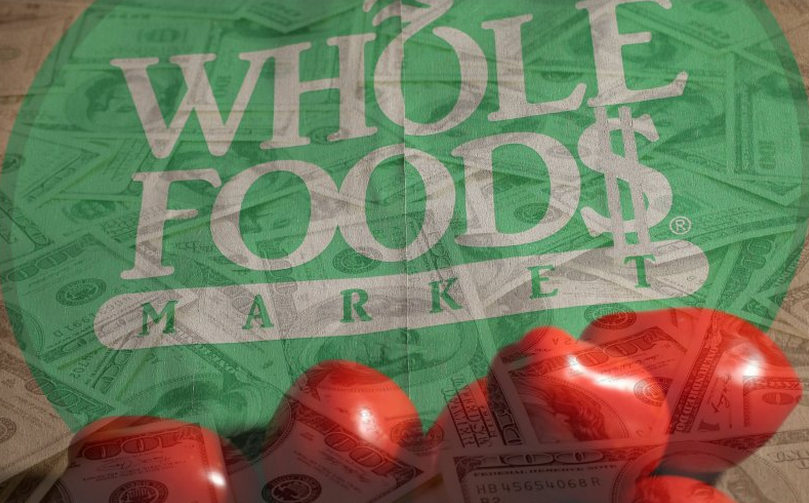Writing about science-and-society controversies can be a bit like running laps on a track, or watching Teletubbies, or listening to a fugue. The same things keep happening again and again.
Take this recent experience of déjà vu: Back in the day (i.e. the mid-aughts), creationists went through a phase of putting labels on textbooks. The labels were often accurate, technically speaking. They explained that evolution was a theory, and that it was controversial—both true things. In court, labelers could argue that they were just trying to give students choices, while encouraging critical thinking. Their opponents suggested that the labels, even if they were accurate, were fundamentally deceptive.
Anyway, as for the déjà vu: A few months back, I was spending an afternoon in the aisles of a Whole Foods Market, preparing for an article about pseudoscience in the organic grocery store, when I started to notice, on food packaging in every aisle, innocuous little labels: “Non-GMO Project Verified.” The labels included apicture of a butterfly on a blade of grass. They were cute, they were informative, and they assured consumers that this food, at least, did not contain ingredients engineered in a lab.
I should note, here, that genetically modified organisms (GMOs) present a much subtler, much thornier issue than the increasingly quaint Genesis-versus-Darwin spat. If someone tells you that GMOs are 100-percent-safe-and-great-forever-and-ever-amen, then that person is lying to you.
Still, those cute butterflies aren’t all that different from the textbook labels. They’re blandly worded, adept at manufacturing the appearance of danger, and supported by institutions with a vested interest in creating a cultural conflict. And, as the debate over GMO labeling heats up, they can tell us a lot about the delicate line between an intelligent conversation about science and a full-scale culture war meltdown.
A label like that of the Non-GMO Project, though, isuniquely effective at making GMOs seem scary. It highlights—and exaggerates—the prevalence of GMOs in other sections of your grocery store.
The idea behind the labeling of GMOs is simple, logical, and appealingly democratic. Many consumers are worried about GMOs in their food. A label helps them avoid those products. People have the right to know what’s in their food. In Europe, where fear of GMOs is much more widespread than in the United States, labeling is a common practice.
Today, Just Label It, an outreach and lobbying nonprofit in Washington, D.C., pushes for mandatory disclosure for foods that contain any genetically modified ingredients. The Non-GMO Project, on the other hand, provides a voluntary way for manufacturers to declare themselves GMO free. The Project has verified more than 20,000 products across more than 2,000 brands. Whole Foods has been a leading partner in this effort, requiring all of its providers to be GMO-free or GMO-labeled by 2018, and using the Non-GMO Project to certify Whole Foods’ in-house brands. Increasingly, though, the Project’s logo is also popping up on more conventional foods—things like Post cereals. Both Just Label It and the Non-GMO Project receive the bulk of their donations from natural foods companies. They are, essentially, industry nonprofits.
Putting a butterfly on food boxes may seem harmless. Dig deeper, though, and these tactics start to look somewhat deceptive. For one thing, the United States organic standards system already requires that foods be GMO-free. If a consumer wants to avoid GMOs, there’s a government-regulated system already in place to guide them in making that choice. Non-GMO Project Executive Director Megan Westgate told The Daily Beast that the Project provides closer GMO oversight than the USDA.
For another thing, many of the foods that the Project certifies don’t have any genetically modified alternatives on the market. There are only a few food plants in the United States that have their genomes tweaked in a lab, rather than by traditional breeding and hybridization, which is how people have genetically engineered plants for millennia.
As a result, the Non-GMO Project seal often implies that a product—say, a bag of almonds—is different than other products on the market, even when it’s not (almonds aren’t genetically engineered for sale). “It ends up creating more confusion,” said Violet Batcha, the communications manager for Just Label It, which advocates for mandatory, rather than voluntary, labeling.
A label like that of the Non-GMO Project, though, is uniquely effective at making GMOs seem scary. It highlights—and exaggerates—the prevalence of GMOs in other sections of your grocery store. It implies that GMOs are the opposite of butterflies and blades of grass. And let’s be clear: The opposite of a butterfly must be something terrible indeed.
In the past few years, entities as diverse as the American Association for the Advancement of Science (which publishes the prestigious journal Science), the Boston Globe editorial page, and Scientific American have come out against the labeling of genetically modified foods.
When people become scared of something like GMOs, a company like Whole Foods stands to profit.
Their reasons are simple: Massive studies and reviews conducted by academic scientists, United States government researchers, and the much more GMO-skeptical European Union have found that GMOs, while not without risks, are relatively safe, and have the potential for significant social benefits. And labels warning about genetic engineering tend to scare consumers, and give the impression that GMOs are more dangerous than they are.
There’s something terribly paternalistic about this concern that shoppers don’t understand GMOs, and so can’t be trusted with labels. “I think it’s really insulting to the consumer,” Westgate said. Still, as anyone who’s ever watched TV commercials during election season will know, giving information to someone doesn’t necessarily make them more informed.
Plopping an emotionally charged word onto a food package, without any sort of context, may not help consumers know anything more about what they’re eating—and it can, again, exaggerate the dangers of GMOs considerably. It is “in the nature of modest, informational regulations to breed concerns capable of supporting stronger, substantive regulation,” writes Dan Kahan, a scholar at Yale Law School and expert in the communication of scientific data.
Both Westgate and Batcha, the Just Label It spokesperson, emphasize that consumer advocacy and transparency are their goals, not GMO-bashing. Both their organization’s websites, though, take a blatant anti-GMO tone. And it’s clear why natural foods companies might have a stake in making GMOs into a more controversial issue. A story of dangerous agribusinesses versus scrappy little farmers fits well into their larger sales narrative. And organic producers are sitting on some of the best GMO-free supply chains in the United States. When people become scared of something like GMOs, a company like Whole Foods stands to profit.
Three of Just Label It’s major supporters, for example—Annie’s Homegrown, Ben & Jerry’s, and Honest Tea—are owned by companies on Just Label It’s list of major GMO offenders.
For some of the natural food-oriented companies that back GMO labeling, it’s fairly obvious that idealism isn’t their only motive, because they’re owned by major agribusiness companies that use GMOs and oppose labeling. Three of Just Label It’s major supporters, for example—Annie’s Homegrown, Ben & Jerry’s, and Honest Tea—are owned by companies on Just Label It’s list of major GMO offenders (General Mills, Unilever, and Coca-Cola, respectively).
Wherever there is controversy, there will be those who wish to profit off of it. In this case, the stakes are high. We need to figure out a way to feed a growing population on a warming planet. GMOs offer one way to help address that challenge. As science journalist Michael Specter recently chronicled in The New Yorker, the knee-jerk rejection of GMOs can have serious consequences for pesticide use, farmers’ well-being, and nutrition.
Embracing GMOs blindly has its risks, of course. The danger, here, is not a society where people express concerns about genetic engineering. That’s the kind of society that we do want to live in. The danger is a society where GMOs come to feel like an us-versus-them issue; where, in short, you’re either pro-GMO, or you’re non-GMO, with almost no room for anyone who falls in between the labels.



